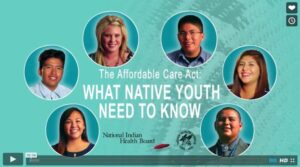
Click here to watch the Native youth Toolkit on the Affordable Care Act
With the launching of Generation Indigenous in 2014, the Obama Administration showed the American people the heritage, tradition, and perseverance of Native people in this country. But more importantly, this movement helped Native youth to recognize the responsibility of continuing this energy for generations to come.
The direct creation of Generation Indigenous is to help remove barriers that stand between Native youth and their opportunity to succeed. While these barriers are numerous for many Native youth, the National Indian Health Board acknowledges that some of the most debilitating barriers to success that a young Native person faces are directly related to the health and wellbeing of themselves and their communities. According to the Centers for Disease Control the American Indian and Alaska Native (AI/AN) youth demographic has drastic rates of diabetes type 1 and 2 among people younger than twenty years old[i]. Furthermore, AI/AN adolescents are 50 percent more likely than non-Hispanic Whites to be overweight[ii]. These statistics illustrate problems around obtaining a quality of health and wellness for young people in Indian Country that is promised through the Federal Trust Responsibilities. These statistics do not highlight the additional barriers unique to Indian Country for addressing health disparities such as accessing affordable health insurance, proximity to quality healthcare providers, and other factors that make access to quality health care services in Indian Country difficult for Native youth and their families.
With the passing the Affordable Care Act, AI/AN’s received unprecedented access health care systems. Special benefits and protections specifically codified for improved access to quality healthcare systems were put in place for AI/AN’s. The National Indian Health Board works daily with a variety of federal partners provide outreach and education to AI/AN’s on this important law.
It is here that we see the intersection of three causes which we believe are high priorities ; young people, the Native population, and those impacted by health care reform through the Affordable Care Act. For this reason the National Indian Health Board is launching a new campaign focused specifically on engaging Native Youth across Indian Country about their rights and access to quality health care in this country. By empowering youth with the knowledge about how to protect their health beyond the resources formally provided to them, they not only benefit directly, but become valuable advocates in their community for health care reform in Indian Country.
The first content for this campaign has just been created by NIHB in partnership with the Indian Health Service. By engaging directly with Native youth from all across Indian Country who represented over 17 tribal nations and participated in NIHB’s 2015 Native Youth Summit, the “Affordable Care Act: What Native Youth Need To Know” toolkit comprises of a brochure and poster series and a short film production. As shown above, the film feature in this toolkit follows future leaders of Indian Country as they experience Washington D.C. at the NIHB Youth Summit and interact with members of the Senate, leading policy officials, and engage with concepts of the Affordable Care Act and Tribal healthcare. The film then follows several of these Native leaders to their home communities where they reflect on the lessons they learned in Washington D.C. and the importance of Tribal health care reform for them and their communities. The story told through this toolkit is one that is a matter of quality of life for many youth, elders, and families across Indian Country.
The objectives of this new Toolkit are as follows:
- Introduce Native youth to concepts of the Affordable Care Act, Medicaid, and health insurance coverages.
- Encourage Native youth to learn more about concepts of the Affordable Care Act, Medicaid, and health insurance coverages from their local Patient Benefit Coordinator (PBC) or Enrollment Assistor Entities.
- Engage Native youth to become advocates for Tribal Health Care Reform and resources for a healthier Indian Country.
[i] Centers for Disease Control and Prevention. National Diabetes Statistics Report: Estimates of Diabetes and Its Burden in the United States, 2014. Atlanta, GA: U.S. Department of Health and Human Services; 2014.
[ii] U.S. Department of Health and Human Services Office of Minority Health. Obesity and American Indians/Alaska Natives, 2016.